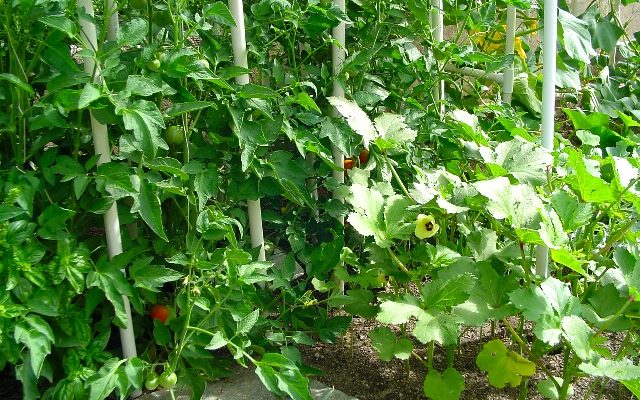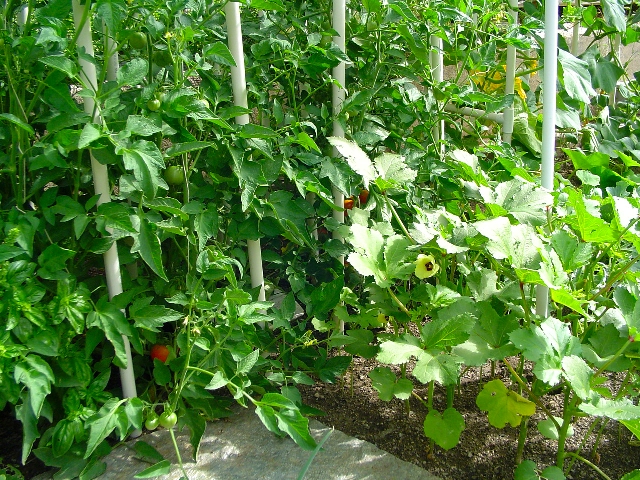More Good Reasons To Start An Urban Organic Garden
If your vision of paradise includes stepping out to a bountiful, sunlit garden to pick perfect fruits from abundantly fertile plants, you’re not alone. Perhaps this imagery is deeply rooted in our psyches through the biblical story of Eden. Perhaps the pleasures of the kitchen garden have been unconsciously transmitted ancestor to ancestor to us through the real life enjoyments of simpler times. The flavors and scents of our plant foods and flowers can be counted among the richest gifts we receive from the planet. It’s not hard to feel grateful and blessed when the garden is right outside the door offering up something delicious to eat. The happiness we feel from appreciation, participation in a little slice of paradise, enjoyment of high quality foods, do we need any more reasons to grow a garden?
Actually, there are some more. In the summer of 2008 with worrisome stock market declines and a bet that economic hard times were just around the corner, I challenged myself to grow as much food as I could in my small, urban backyard using sustainable, organic methods. And I did it, producing more food than I’d imagined. But economic savings is just one more benefit of growing food at home. There are numerous health advantages. For one thing, what goes into the plants remains completely in the gardener’s control, so enhanced mineral content and food purity can be assured; harvesting at peak freshness and ripeness can also be guaranteed. Studies from communities where a large percentage of the inhabitants live to be a hundred always include the fact that the people there are eating a mostly plant-based diet, often, of home-grown produce.
Small Spaces Can Produce Big Yields
Having only a small space for growing need not be an obstacle to growing big yields of vegetables when intensive gardening methods are put to work. It’s a matter of pushing boundaries by spacing plants densely, growing them higher vertically, and for a longer season than with traditional gardening methods. Such intense cultivation also requires excellent soil fertility. All of these aims can successfully be achieved in a small space with a little know-how and some inexpensive resources.
By minimizing the space for walking and working in the garden and also spacing plants as closely as their natures allow, plant yields per area can be increased. Plants crowd together in nature’s fields, why not in the backyard vegetable garden? Varieties with a vining nature can be trained to grow higher on trellises instead of bushier ground-level growth. Supports can be made from different materials, such as wood or metal. I’ve found PVC plastic pipes and their fittings to be excellent materials for constructing simple, snap-together trellis structures that are inexpensive, sturdy, durable, and space-saving.
A Longer Harvest Season
We can get the most out of time as well as space by using methods that lengthen the growing season. Successive planting will keep the garden productive throughout most of the year. Building a simple and portable greenhouse can add three months of food harvesting to the year. Various cooling strategies in hot weather and warming strategies in cold weather can also extend the harvest.
To succeed with such intensive gardening, deep, fertile soil is a must. If we think of the vegetable garden as a food chain with the gardener at the top, we see that each level depends on the nourishment of the level below. We can add the microorganisms that the plants eat and the minerals that the microorganisms eat. There are naturally-occurring crushed rock products available that are loaded with the minerals and trace minerals that feed the microorganisms that transform minerals into more bio-available forms for the plants. Microorganisms can be added to the soil through various composting methods. For those with little space, the bokashi composting method is a simple way to add friendly microbes by recycling kitchen and yard waste quickly, inexpensively and tidily without the need for bins or drums or space-hogging, vermin-haunting piles.
There are so many reasons to grow vegetables at home. We can choose heirloom seed varieties and harvest seeds for the next crop, or we can experiment with the more exotic and colorful vegetable varieties that rarely make it to consumer shelves.
Reaping All The Rewards
Is gardening a lot of work? Perhaps there are two answers to this question. Sure, there’s work, especially the initial set-up of the garden beds. On the other hand, for many people gardening is play. It is also most certainly balanced exercise, re-connection with nature, and an absorbing, fulfilling pastime with both spiritual and material rewards.




